Press Release
ESO’s First Observatory Celebrates 40th Anniversary
24 March 2009
ESO’s La Silla Observatory, which is celebrating its 40th anniversary, became the largest astronomical observatory of its time. It led Europe to the frontline of astronomical research, and is still one of the most scientifically productive in ground-based astronomy.
With about 300 refereed publications attributable to the work of the observatory per year, La Silla remains at the forefront of astronomy. It has led to an enormous number of scientific discoveries, including several “firsts”. The HARPS spectrograph is the world’s foremost exoplanet hunter. It detected the system around Gliese 581, which contains what may be the first known rocky planet in a habitable zone, outside the Solar System (eso0722). Several telescopes at La Silla played a crucial role in discovering that the expansion of the Universe is accelerating and in linking gamma-ray bursts — the most energetic explosions in the Universe since the Big Bang – with the explosions of massive stars. Since 1987, the ESO La Silla Observatory has also played an important role in the study and follow-up of the nearest supernova, SN 1987A (eso0708).
“The La Silla Observatory continues to offer the astronomical community exceptional capabilities,” says ESO Director General, Tim de Zeeuw. “It was ESO’s first presence in Chile and as such, it triggered a very long and fruitful collaboration with this country and its scientific community.”
The La Silla Observatory is located at the edge of the Chilean Atacama Desert, one of the driest and loneliest areas of the world. Like other observatories in this geographical area, La Silla is located far from sources of polluting light and, as the Paranal Observatory that houses the Very Large Telescope, it has one of the darkest and clearest night skies on the Earth.
At its peak, La Silla was home to no fewer than 15 telescopes, among them the first — and, for a very long time, the only — telescope working in submillimetric waves (the 15-metre SEST) in the southern hemisphere, which paved the way for APEX and ALMA, and the 1-metre Schmidt telescope, which completed the first photographic mapping of the southern sky. The telescopes at La Silla have also supported countless space missions, e.g., by obtaining the last images of comet Shoemaker Levy 9 before it crashed into Jupiter, thereby helping predicting the exact moment when the Galileo spacecraft should observe to capture images of the cosmic collision.
“Many of the current generation of astronomers were trained on La Silla where they got their first experience with what were then considered large telescopes,” says Bruno Leibundgut, ESO Director for Science.
While some of the smaller telescopes have been closed over the years, frontline observations continue with the larger telescopes, aided by new and innovative astronomical instruments. La Silla currently hosts two of the most productive 4-metre class telescopes in the world, the 3.5-metre New Technology Telescope (NTT) and the 3.6-metre ESO telescope.
"The NTT broke new ground for telescope engineering and design," says Andreas Kaufer, director of the La Silla Paranal Observatory. The NTT was the first in the world to have a computer-controlled main mirror (active optics), a technology developed at ESO and now applied to the VLT and most of the world’s current large telescopes. The ESO 3.6-metre telescope, which was for many years one of the largest European telescopes in operation, is now home to the extrasolar planet hunter, HARPS (High Accuracy Radial velocity Planet Searcher), a spectrograph with unrivalled precision.
The infrastructure of La Silla is used by many of the ESO member states for targeted projects such as the Swiss 1.2-metre Euler telescope, the Italian Rapid-Eye Mount (REM) and French TAROT gamma-ray burst chasers as well as more common user facilities such as the 2.2-metre telescope of the German Max Planck Society and the 1.5-metre Danish telescopes. The 67-million pixel Wide Field Imager on the 2.2-metre telescope has taken many amazing images of celestial objects, some of which have now become icons of their own.
The La Silla Observatory, north of the town of La Serena, has been a stronghold of the organisation’s capabilities since the 1960s. The site was chosen after an initial prospecting expedition — partly on horseback — to the Chilean Andes, during 1963 and 1964, by the first ESO Director General, Otto Heckmann, and several senior astronomers. This was done with the help of AURA, which had just chosen to install an observatory at nearby Cerro Tololo. In the following years, the site was developed and the first small and mid-sized telescopes were erected, followed by the 3.6-metre telescope in 1977 and the NTT in 1989. On 25 March 1969, an audience of more than 300 people, including the then Chilean President, Eduardo Frei and the Minister of Education of Sweden, Olof Palme, celebrated the completion of the first phase of the construction programme.
“The erection of the La Silla Observatory is not only of vast importance for the future of astronomical research, but also a striking example of what may be achieved through efficient, and truly far-reaching, international cooperation,” said Olof Palme at the time.
The future of the La Silla Observatory remains bright. In 2007 ESO’s Council endorsed a plan that maintains an important role for La Silla, alongside the other large ESO facilities, the VLT, ALMA and the E-ELT.
La Silla also plans to host new national telescope projects and visitor instruments — an option that has already received a strong positive response from the astronomical community.
More information
- More about La Silla
- Images of La Silla
- ESO Timeline
Contacts
Andreas Kaufer
ESO
Chile
Tel: +49 89 3200 5303
Email: akaufer@eso.org
Henri Boffin
ESO
Garching, Germany
Tel: +49 89 3200 6222
Email: hboffin@eso.org
Valentina Rodriguez
ESO
Chile
Tel: +56 2 463 3123
Email: vrodrigu@eso.org
About the Release
| Release No.: | eso0912 |
| Legacy ID: | PR 12/09 |
| Name: | La Silla |
| Type: | Unspecified : Technology : Observatory |
| Facility: | Other |





